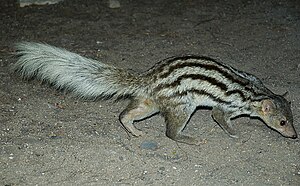Broad-striped mongoose
| Broad-striped mongoose | ||||||||||||
|---|---|---|---|---|---|---|---|---|---|---|---|---|

Greater broad-striped mongoose ( Galidictis grandidieri ) |
||||||||||||
| Systematics | ||||||||||||
|
||||||||||||
| Scientific name | ||||||||||||
| Galidictis | ||||||||||||
| I. Geoffroy Saint-Hilaire , 1839 |
The galidictis or bands Mungos ( Galidictis ) are in Madagascar living predator species from the group of Malagasy predators (Eupleridae). There are two types:
- the broad-striped mongoose ( Galidictis fasciata ) and
- the great broad-striped mongoose ( Galidictis grandidieri ).
Like all Madagascar mongooses , broad-striped mongooses have a slender, elongated body with short limbs and bushy black. Their fur is gray-brown in color, the name-giving feature are the five to ten dark longitudinal stripes, which are separated by light stripes and extend from the neck to the base of the tail. The head is flat, the muzzle pointed, and the bushy tail is white or light gray in color. These animals reach a head body length of 30 to 48 centimeters, a tail length of 25 to 33 centimeters and a weight of 500 to 1500 grams.
These animals live in Madagascar. While the broad-striped mongoose inhabits the rainforests in the east of the island, the large broad-striped mongoose is native to the thorn forests in the southwest.
Little is known about their way of life. They are nocturnal and mainly stay on the ground, but can climb well. Most of the observations come from solitary animals or animals living in pairs, rarely from groups of up to five. Their diet consists of small vertebrates such as rodents, lemurs, amphibians and reptiles, as well as invertebrates such as cockroaches, grasshoppers and others.
literature
- Ernest P. Walker (greeting), Ronald M. Nowak (arr.): Walker's Mammals of the World . 6th ed. Johns Hopkins University Press, Baltimore 1999, ISBN 0-8018-5789-9 (2 vols.).
- Don E. Wilson, Russell Mittermeier (eds.): Handbook of the Mammals of the World, Vol. 1: Carnivores. Lynx Edicions, Barcelona 2009, ISBN 978-84-96553-49-1 .